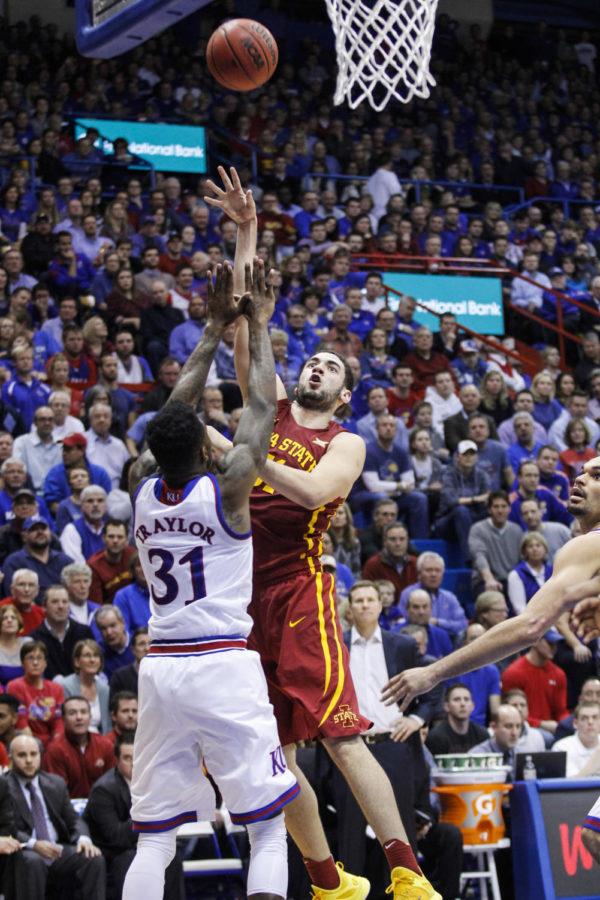Niang’s efficiency key to Iowa State’s success
Junior forward Georges Niang attempts a shot against Kansas at Lawrence, Kan. on Feb. 2. The Cyclones fell to the Jayhawks in a heart-breaking 89-76 loss. Niang had 24 points for Iowa State.
February 12, 2015
Scan the stat sheets of ISU wins and a pattern starts to develop. Monté Morris will have an assist-to-turnover ratio of about 5-to-1, Jameel McKay will have about two blocks and Naz Long will have a few 3-pointers.
But take a look at Georges Niang’s stat line — one riddled with numbers in nearly every statistical category — and see the reason why he has been named to the Wooden Award Late Season Top 20 players in the nation. With 18 double-digit scoring efforts in 23 games and averaging 14.9 points, 5.3 rebounds and 3.5 assists per game, Niang does things for the Cyclones that few players in the country can claim.
It’s why Texas coach Rick Barnes and TCU coach Trent Johnson went out of their way to mention Niang in their post-game press conferences, Johnson calling Niang the best player in the country. But don’t expect Niang to take the credit.
“That’s great, but the team I play on helps me succeed and that’s really who I owe it to,” Niang said, responding to Johnson’s comments. “Playing for the best coach in America and with the best point guard in America, I’m really in a great situation for me to look good.”
The key to “looking good” is Niang’s efficiency. Niang gets 15.9 points, 5.2 rebounds and 3.5 assists in ISU wins, giving him one of the most balanced stat lines on the team.
However, in losses this season, Niang’s production hardly looks different. At 11.8 points, 5.8 rebounds and 3.2 assists per game, the problem seems to be anything but Niang, but it’s how those points are scored that unveils the true problem.
In wins, Niang averages 1.48 points per shot attempt — well above the team average of 1.33 points per shot attempt. In losses, his points per shot attempt drops to 0.92. With a scoring output of 11.8 points per game, that means one thing, lots of shots.
The high volume of shots by Niang in losses is not even a ball-hog issue. Much of the problem can be put on spacing, an issue mentioned by players and coaches in nearly every loss. It’s a key contributor in blocked-off passing lanes that lead to turnovers and tightly-contested shots due to less ball movement. And who does Hoiberg trust to create offense more than anyone on the floor? Georges Niang.
“You get the ball to Georges in the paint … he’s usually going to make the right play,” Hoiberg said. “When you get Georges and Monté [Morris] out there playing a two-man game, generally good things happen.”
In fact, he does it more often than not. When spacing was off against Kansas on the road, Niang took matters into his own hands, scoring 24 points on 9-of-18 shooting, while dishing out five assists. It’s how he’s operated for more than two seasons now, creating plays when nothing seems available.
But when he’s off, the team will need to rely on other players to be more efficient, an adjustment that has gradually been made since the start of the conference season. Against Texas Tech at home, Niang played only 19 minutes, making room for Jameel McKay to step up in his most efficient game of the year.
However, the Cyclones are at their best when Niang is at the top of his game. Shooting more than 50 percent and averaging 16.0 points per game in his last five games, he may have his best basketball ahead of him.
“I feel like I’m getting in a good rhythm,” Niang said recently after the TCU game. “The guys are really doing a great job of finding me in spots where I can really be effective. The most credit goes to them, they’re doing a great job of finding me and I’m just making the shots I make every day.”







